Comet 21P/Giacobini-Zinner. Shot on August 18, 2018, from Moscow Region, Russia. Used Canon 600D and guided Celestron AVX 8″ with focal reducer. Stack of 90 frames * 2 minute each (plus calibration frames). Calibration and processing in PixInsight 1.8. Photo by Alexander Vasenin via Wikimedia Commons.
There’s exciting news about two comets, one in our sky now, and one about to be. The first – comet 21P/Giacobini-Zinner, parent object of the Draconid meteor shower – is being picked up with small telescopes now. It’s about to come closer to Earth than it has in 72 years! The other – comet Wirtanen – will come even closer and might become visible to the unaided eye later this year.
Comet 21P/Giacobini-Zinner – affectionately called simply 21P by astronomers – is currently approaching the Earth and sun at incredible speeds (about 14 miles/second, or 23 km/s). Its closest approach to both the Earth and the sun take place on the same day – September 10, 2018 – when this comet will sweep past Earth at a completely safe distance of 36 million miles (58 million km) from our planet. That’s nearly as far from us as the next planet outward in orbit – Mars – is right now. But, for a comet, it’s relatively close.
And that’s one reason astronomers are excited. But there are more reasons!
During the first half of September, comet 21P/Giacobini-Zinner will be visible with binoculars. The comet, which is expected to reach a visual magnitude of 6.5 to 7. That means it will not be visible to the eye … but nearly.
Around this time, 21P will be passing in front of the constellations Camelopardalis, Perseus, and Auriga.
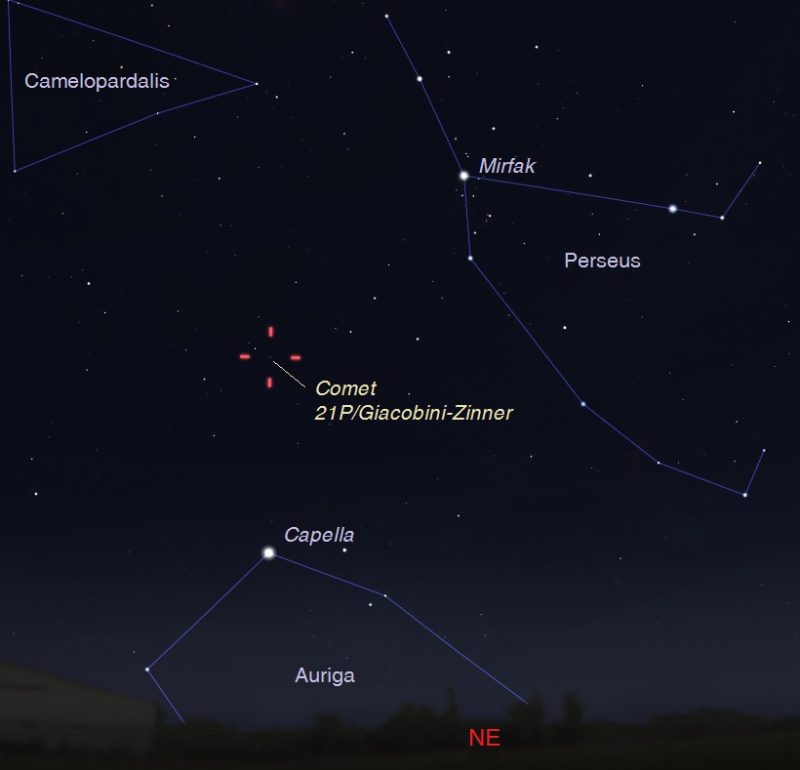
Location of comet 21P/Giacobini-Zinner on August 29, 2018, at 11:45 p.m. CDT, as seen from the central U.S., facing northeast. Illustration by Eddie Irizarry using Stellarium.
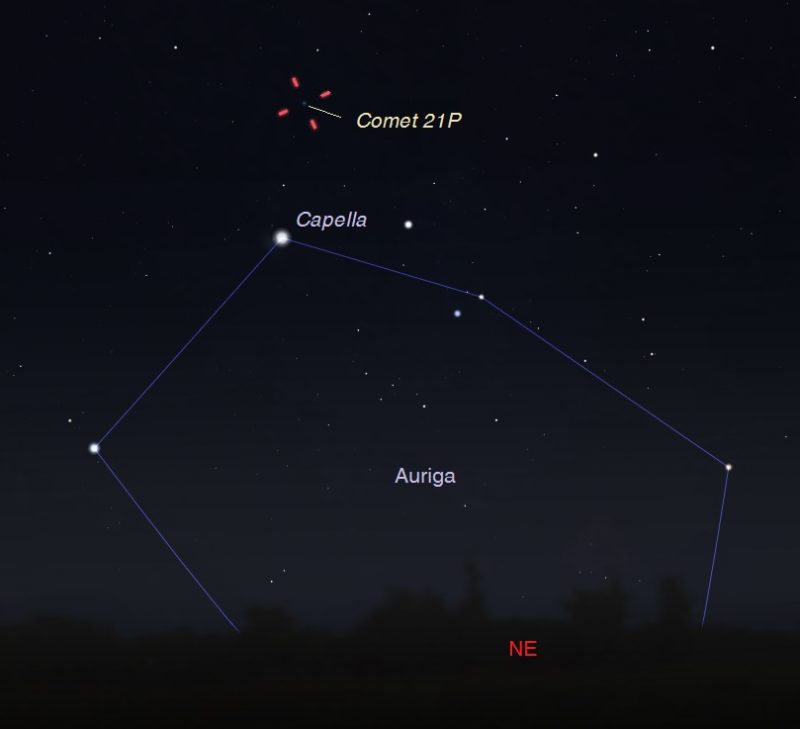
On September 1, 2018, at 11:55 p.m. comet 21P is located not too far from Capella, the bright star visible near the horizon in the northeast direction, as seen from the central U.S. The comet passes about twice the apparent moon diameter from Capella. Illustration by Eddie Irizarry using Stellarium.
Because approach to Earth happens on the night of September 9-10 (September 10 at 06:27 UTC to be exact)- the same day as the comet’s perihelion – Saturday, September 8, is also a good night to get a glimpse at the celestial visitor. On that date, it will be visible in front of the constellation Auriga.
Using binoculars or a small telescope, you will be able to find the comet as a fuzzy patch of light, if you observe at the right direction. See the illustration below.
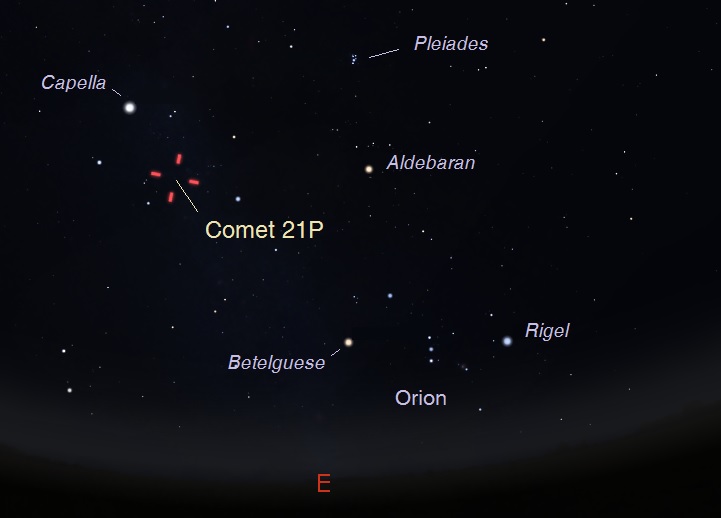
The illustration shows the comet location on September 9, 2018, at 3 a.m. CDT, as seen from the central U.S. Observers using computerized telescopes can point their instruments at RA 5h38m46s / DEC +36º31’30.6″ a few minutes before that time. Illustration by Eddie Irizarry using Stellarium.
Although the nucleus of comet 21P/Giacobini-Zinner is estimated to be just over a mile (about 2 km) wide, the heat the comet is now feeling from the sun has caused it to develop a coma or cometary atmosphere some 180,000 miles (about 290,000 km) in diameter, according to observations by Northolt Branch Observatories in London.
This means comet 21P now has an atmosphere about twice the diameter of our solar system’s biggest planet, Jupiter!
Some images show the comet’s coma as a green color, which indicates the comet has cyanogen and diatomic carbon, gases that glow in green color as they’re illuminated by sunlight.
Using a small telescope, carefully observe which stars are close to the comet’s nucleus, and then compare the view just 15 or 30 minutes later; you will be able to detect its motion. Comet 21P is travelling through space at 50,555 miles per hour (81,360 km/h) relative to Earth.
Late on the night of September 10-11, the comet passes very close to Messier 37, aka M37, the richest and brightest open cluster in the constellation Auriga. See illustration below.
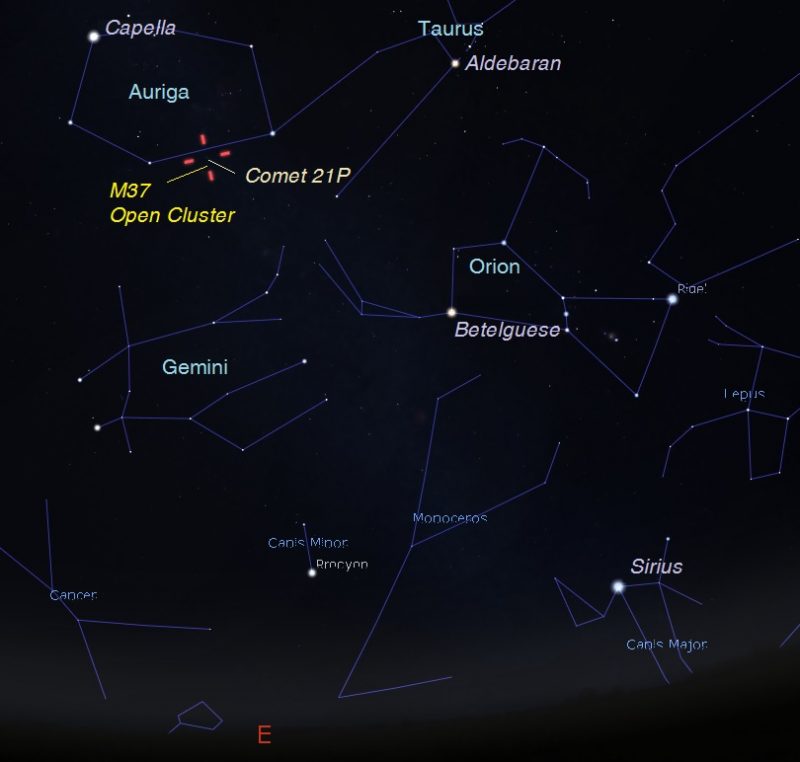
On September 11, 2018, at 4:30 a.m., comet 21P passes almost in front of open cluster M37 in Auriga. This view shows the close encounter as seen from the central U.S., facing east. Illustration by Eddie Irizarry using Stellarium.
Meanwhile, if you don’t want to wait 40 years, take a good look at Comet 21P/Giacobini-Zinner, as its next best close approach occurs on September 18, 2058.
Now about that meteor shower. As it orbits the sun, 21P produces some debris, causing the Draconid meteor shower. In 2018, Draconids will probably be seen on the evening of October 7 or 8, close to the new moon phase. The Draconids are not known for being an outstanding shower in most years. But, when a parent comet is nearby, the resulting meteor shower can be spectacular. We haven’t seen any predictions for a spectacular Draconid shower in 2018 … yet. But it’s definitely a shower worth watching. Read more … All you need to know: Draconids in 2018.
Comet 21P was discovered on December 20, 1900 by Michel Giacobini from France, and then was seen again or recovered from Germany by Ernst Zinner, in October, 1913. It is a frequent visitor to Earth, with an orbit around the sun lasting 6.6 years.
Amateur astronomers are getting nice images of Comet 21P even with small telescopes, like this one taken August 22, 2018, with an 80 mm refractor by Alex Guadalupe from Puerto Rico.
Another comet approaching Earth is 46P/Wirtanen. In December, 2018 comet Wirtanen might be visible with the unaided eye, at least from dark skies. Closest approach to the sun will be December 12, 2018, and closest approach to Earth is just a few days later, on December 16. According to astronomers at the University of Maryland, this passage of comet Wirtanen near the Earth (near by comet standards, that is) will be the 10th closest approach of a comet in modern times. At its closest to us, the comet will be about 30 times the moon’s distance (7.1 million miles, or 11.5 million km). Contrast that number to the number of 21P/Giacobini-Zinner’s closest approach to Earth (36 million miles, or 58 million km).
Estimates indicate Wirtanen might reach a visual magnitude of 3.5 to 6. That would place the comet clearly in the realm of visibility with the unaided eye (although diffuse objects like comets are tougher to see than the pinpoints of stars at comparable magnitudes).
And, of course, comets have shown to be unpredictable. We will keep you updated.
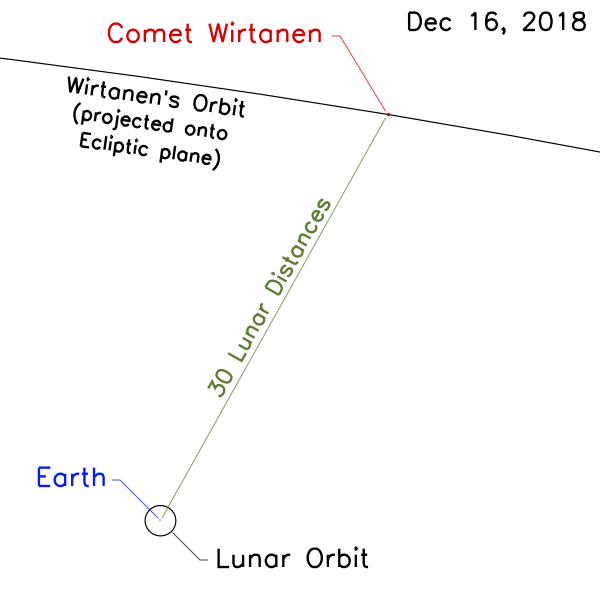
The December 16, 2018, close approach to Earth of comet Wirtanen will happen less than 4 days after the comet’s perihelion, or closest point to the sun. Because comets are increasingly active as they draw nearer the sun that binds them in orbit, this comet can be expected to be near its brightest around then. It might be visible to the eye from a dark location. Image via University of Maryland.
Bottom line: Here are two comets to watch for in the months ahead, comet 21P/Giacobini-Zinner, coming closest to Earth in September, 2018 – and comet Wirtanen, coming closest in December.
from EarthSky https://ift.tt/2LwsMnC
Comet 21P/Giacobini-Zinner. Shot on August 18, 2018, from Moscow Region, Russia. Used Canon 600D and guided Celestron AVX 8″ with focal reducer. Stack of 90 frames * 2 minute each (plus calibration frames). Calibration and processing in PixInsight 1.8. Photo by Alexander Vasenin via Wikimedia Commons.
There’s exciting news about two comets, one in our sky now, and one about to be. The first – comet 21P/Giacobini-Zinner, parent object of the Draconid meteor shower – is being picked up with small telescopes now. It’s about to come closer to Earth than it has in 72 years! The other – comet Wirtanen – will come even closer and might become visible to the unaided eye later this year.
Comet 21P/Giacobini-Zinner – affectionately called simply 21P by astronomers – is currently approaching the Earth and sun at incredible speeds (about 14 miles/second, or 23 km/s). Its closest approach to both the Earth and the sun take place on the same day – September 10, 2018 – when this comet will sweep past Earth at a completely safe distance of 36 million miles (58 million km) from our planet. That’s nearly as far from us as the next planet outward in orbit – Mars – is right now. But, for a comet, it’s relatively close.
And that’s one reason astronomers are excited. But there are more reasons!
During the first half of September, comet 21P/Giacobini-Zinner will be visible with binoculars. The comet, which is expected to reach a visual magnitude of 6.5 to 7. That means it will not be visible to the eye … but nearly.
Around this time, 21P will be passing in front of the constellations Camelopardalis, Perseus, and Auriga.

Location of comet 21P/Giacobini-Zinner on August 29, 2018, at 11:45 p.m. CDT, as seen from the central U.S., facing northeast. Illustration by Eddie Irizarry using Stellarium.

On September 1, 2018, at 11:55 p.m. comet 21P is located not too far from Capella, the bright star visible near the horizon in the northeast direction, as seen from the central U.S. The comet passes about twice the apparent moon diameter from Capella. Illustration by Eddie Irizarry using Stellarium.
Because approach to Earth happens on the night of September 9-10 (September 10 at 06:27 UTC to be exact)- the same day as the comet’s perihelion – Saturday, September 8, is also a good night to get a glimpse at the celestial visitor. On that date, it will be visible in front of the constellation Auriga.
Using binoculars or a small telescope, you will be able to find the comet as a fuzzy patch of light, if you observe at the right direction. See the illustration below.

The illustration shows the comet location on September 9, 2018, at 3 a.m. CDT, as seen from the central U.S. Observers using computerized telescopes can point their instruments at RA 5h38m46s / DEC +36º31’30.6″ a few minutes before that time. Illustration by Eddie Irizarry using Stellarium.
Although the nucleus of comet 21P/Giacobini-Zinner is estimated to be just over a mile (about 2 km) wide, the heat the comet is now feeling from the sun has caused it to develop a coma or cometary atmosphere some 180,000 miles (about 290,000 km) in diameter, according to observations by Northolt Branch Observatories in London.
This means comet 21P now has an atmosphere about twice the diameter of our solar system’s biggest planet, Jupiter!
Some images show the comet’s coma as a green color, which indicates the comet has cyanogen and diatomic carbon, gases that glow in green color as they’re illuminated by sunlight.
Using a small telescope, carefully observe which stars are close to the comet’s nucleus, and then compare the view just 15 or 30 minutes later; you will be able to detect its motion. Comet 21P is travelling through space at 50,555 miles per hour (81,360 km/h) relative to Earth.
Late on the night of September 10-11, the comet passes very close to Messier 37, aka M37, the richest and brightest open cluster in the constellation Auriga. See illustration below.

On September 11, 2018, at 4:30 a.m., comet 21P passes almost in front of open cluster M37 in Auriga. This view shows the close encounter as seen from the central U.S., facing east. Illustration by Eddie Irizarry using Stellarium.
Meanwhile, if you don’t want to wait 40 years, take a good look at Comet 21P/Giacobini-Zinner, as its next best close approach occurs on September 18, 2058.
Now about that meteor shower. As it orbits the sun, 21P produces some debris, causing the Draconid meteor shower. In 2018, Draconids will probably be seen on the evening of October 7 or 8, close to the new moon phase. The Draconids are not known for being an outstanding shower in most years. But, when a parent comet is nearby, the resulting meteor shower can be spectacular. We haven’t seen any predictions for a spectacular Draconid shower in 2018 … yet. But it’s definitely a shower worth watching. Read more … All you need to know: Draconids in 2018.
Comet 21P was discovered on December 20, 1900 by Michel Giacobini from France, and then was seen again or recovered from Germany by Ernst Zinner, in October, 1913. It is a frequent visitor to Earth, with an orbit around the sun lasting 6.6 years.
Amateur astronomers are getting nice images of Comet 21P even with small telescopes, like this one taken August 22, 2018, with an 80 mm refractor by Alex Guadalupe from Puerto Rico.
Another comet approaching Earth is 46P/Wirtanen. In December, 2018 comet Wirtanen might be visible with the unaided eye, at least from dark skies. Closest approach to the sun will be December 12, 2018, and closest approach to Earth is just a few days later, on December 16. According to astronomers at the University of Maryland, this passage of comet Wirtanen near the Earth (near by comet standards, that is) will be the 10th closest approach of a comet in modern times. At its closest to us, the comet will be about 30 times the moon’s distance (7.1 million miles, or 11.5 million km). Contrast that number to the number of 21P/Giacobini-Zinner’s closest approach to Earth (36 million miles, or 58 million km).
Estimates indicate Wirtanen might reach a visual magnitude of 3.5 to 6. That would place the comet clearly in the realm of visibility with the unaided eye (although diffuse objects like comets are tougher to see than the pinpoints of stars at comparable magnitudes).
And, of course, comets have shown to be unpredictable. We will keep you updated.

The December 16, 2018, close approach to Earth of comet Wirtanen will happen less than 4 days after the comet’s perihelion, or closest point to the sun. Because comets are increasingly active as they draw nearer the sun that binds them in orbit, this comet can be expected to be near its brightest around then. It might be visible to the eye from a dark location. Image via University of Maryland.
Bottom line: Here are two comets to watch for in the months ahead, comet 21P/Giacobini-Zinner, coming closest to Earth in September, 2018 – and comet Wirtanen, coming closest in December.
from EarthSky https://ift.tt/2LwsMnC

Aucun commentaire:
Enregistrer un commentaire